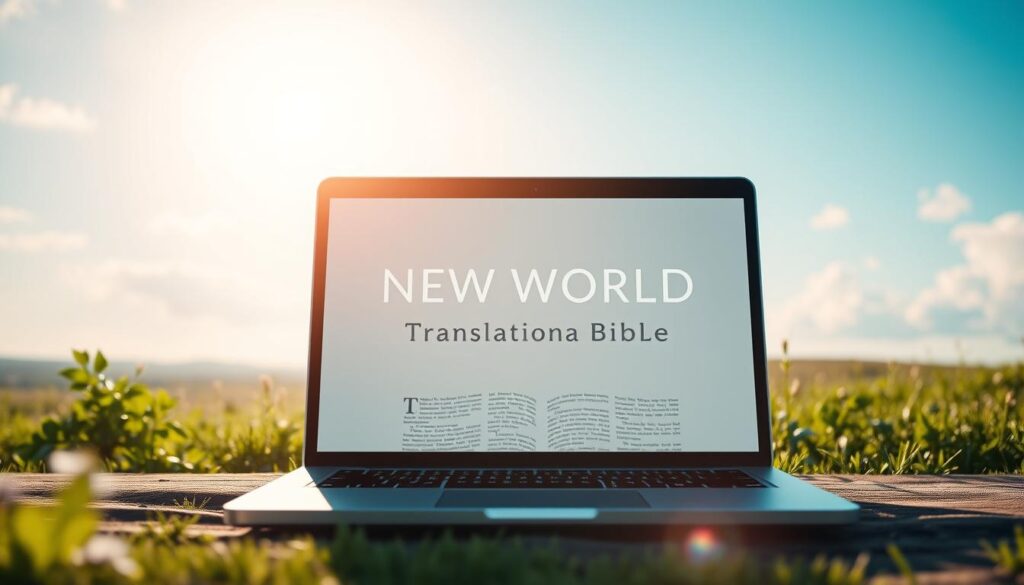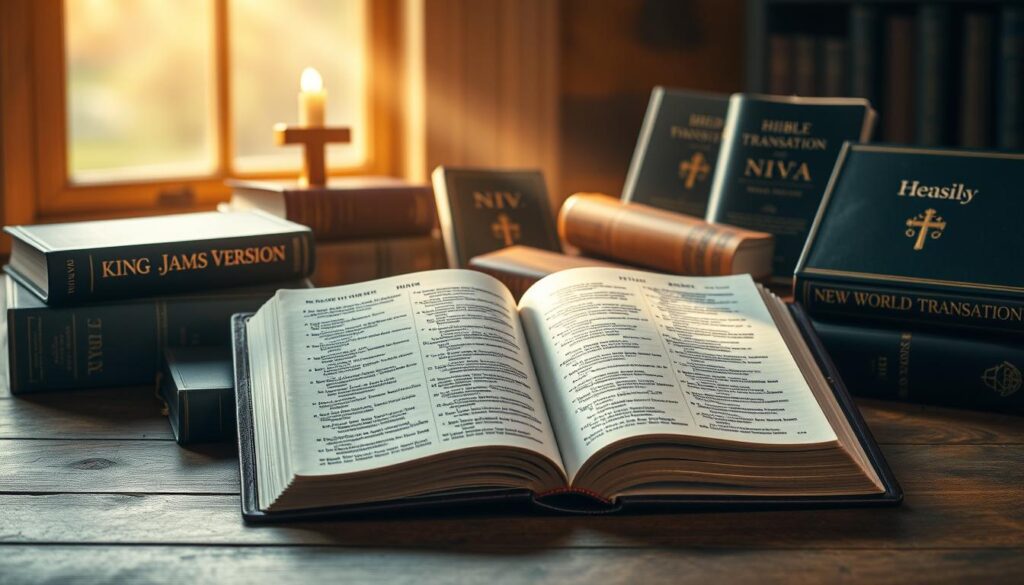Ever pondered how a single translation could influence the beliefs of over 8 million people globally? The Jehovah Witness New World Translation (NWT) is more than a Bible; it’s the textual cornerstone for Jehovah’s Witnesses. It embodies their distinct doctrines and practices. The Watch Tower Bible and Tract Society published it, with over 240 million copies printed and available in more than 300 languages12.
In this article, we’ll examine the New World Translation’s key features and theological implications. We’ll also highlight what makes it stand out from other Bible versions. Join us as we explore its ongoing impact on Jehovah’s Witnesses’ faith practices.
Introduction to the New World Translation
The New World Translation of the Holy Scriptures (NWT) emerged in 1950 with the New Testament. It became a complete version in 1961, becoming a cornerstone for Jehovah’s Witnesses3. Its main goal is to offer a clear, modern Bible translation. It focuses on theological accuracy, reflecting Jehovah’s Witnesses’ beliefs.
Over 240 million copies of the NWT have been printed in 300 languages, showing its global impact2. It uses nearly 16,000 English expressions for about 5,500 Greek terms and over 27,000 for around 8,500 Hebrew terms. This detailed work aims to connect with today’s readers while staying true to the original texts2.
The NWT is also notable for its inclusion of the Tetragrammaton, appearing 6,974 times in the Old Testament3. The translation team, made up of Jehovah’s Witnesses, sought to highlight these key elements. They aimed to present God’s word in a way that reflects their deep convictions about biblical interpretation.
Key Features of the New World Translation
The New World Translation (NWT) stands out for its unique translation style, reflecting the Jehovah’s Witnesses translation style that diverges from mainstream versions. First introduced by the Watchtower in 1950, it is the official New Testament translation for Jehovah’s Witnesses4. A notable aspect is the substitution of “cross” with “torture stake,” highlighting the group’s distinct scriptural interpretation5.
In the NWT, “Jehovah” is used over 200 times in the New Testament, underscoring Jehovah’s Witness emphasis on God’s name5. The translation also alters certain Greek terms, such as “staurós” to “torture stake” instead of “cross”5. This showcases the organization’s theological stance.
The NWT’s handling of key verses showcases its NWT Bible features. For instance, John 1:1 is translated as “the Word was a god,” differing from traditional translations that say “the Word was God”5. This affects doctrinal interpretations significantly. The translation employs unique vocabulary, emphasizing beliefs that diverge from traditional Christian teachings. It omits terms like “sheol,” “hades,” and “gehenna,” which are often translated as “hell” in other Bibles5.

This method aims to make the text understandable to modern readers while adhering to Jehovah’s Witnesses’ teachings. The translation’s focus on specific words and phrases reinforces their scriptural interpretation, often leading to differences when comparing New World Translation vs. other Bibles. The emphasis on contextual translation over strict grammatical rules is key to understanding the NWT’s renderings of phrases like “I am” and others4.
Overall, the NWT’s translation choices reflect Jehovah’s Witnesses’ beliefs, making it a crucial resource for adherents seeking to align with their doctrines.
Theological Implications of the New World Translation
The New World Translation (NWT) is crucial for grasping Jehovah Witness beliefs and its profound theological implications of NWT Bible. It stands out by consistently using “Jehovah,” appearing over 7,000 times, unlike traditional texts that often use “Lord” or “God”6. This choice underscores the belief that accurately representing God is vital for spiritual truth and integrity.
The NWT’s unique terms also shape the interpretation of fundamental doctrines. For instance, it uses “torture stake” instead of “cross,” reflecting a specific perspective on Jesus’ crucifixion7. This aligns with the belief that Jesus is a subordinate “god” to Jehovah, differing from the mainstream Christian belief in the Trinity6. Such translations can alter perceptions of salvation in NWT, especially in passages crucial for understanding eternal life.
Moreover, the NWT alters certain verses, like changing “the Spirit of God” in Genesis 1:2 to “God’s active force,” affecting how readers see the Holy Spirit’s role7. Critics contend that these translations selectively mirror Jehovah’s Witnesses’ theology, often distorting scripture to fit their views on the divine hierarchy8.
How the New World Translation is Used
The NWT Bible study is vital for Jehovah’s Witnesses, offering a framework to grasp their faith. Members delve into the text in personal study, deepening their scripture connection. In group settings, the NWT enhances worship unity by promoting shared reading.
During door-to-door ministry, many Jehovah’s Witnesses use the JW New World Translation. It helps convey their beliefs clearly, ensuring potential converts understand their views. The translation’s anonymity highlights divine inspiration, not individual authorship1.
The NWT stands out as the first complete Bible revised for Jehovah’s Witnesses’ doctrines1. Its adaptability is evident in choices like “torture stake” for “staurós”. It also avoids traditional views of sheol and hades, reflecting the faith’s theological stance19.

Engaging with the NWT bolsters Jehovah’s Witnesses’ beliefs, ensuring consistent teachings. Its unique approach offers a perspective on scripture, reinforcing the faith’s core principles.
Accessing the New World Translation
The New World Translation (NWT) is available in various formats to cater to its diverse readers. It can be accessed online for free through the Jehovah’s Witnesses official website. The site hosts the complete text for digital readers. Moreover, the printed NWT Bible is obtainable through congregations or by direct request, ensuring all members can study and engage with the Bible.
With translations in over 170 languages, the NWT reaches millions of Jehovah’s Witnesses globally. This wide availability allows individuals from different regions to access NWT, facilitating their understanding and application of its teachings. Approximately 8 million Jehovah’s Witnesses worldwide use the NWT, highlighting its importance and influence within the community10.

The text is designed to be user-friendly, whether in print or digital formats. This makes it easy for believers to study and reflect on scriptures as they prefer. The JW website is continually updated, adding new features to improve the user experience for those reading the NWT online. These options ensure that followers can regularly engage with the NWT, deepening their connection with their faith.
| Access Method | Description |
|---|---|
| NWT Online | Available for free download and direct reading on the official JW website. |
| Printed NWT Bible | Obtained through local congregations or via direct request. |
| Language Options | Translations available in over 170 languages for global accessibility. |
| User Experience | Designed with ease of use in mind, adapting to the needs of contemporary readers. |
Comparative Analysis with Other Bible Versions
Exploring the New World Translation (NWT) against the New International Version (NIV) and King James Version (KJV) reveals significant differences in interpretation. The NWT, published by the Watch Tower Bible and Tract Society in 1961, has seen over 220 million copies distributed globally by 201911. When comparing the NWT to the NIV, it’s clear the NWT often aligns with Jehovah’s Witnesses’ doctrines. For example, John 1:1 is translated as “the Word was a god” in the NWT, contrasting with the NIV’s “the Word was God”12.
The NWT’s translation team had limited formal training in biblical languages, raising questions about their accuracy12. Only one member claimed proficiency in both Hebrew and Greek, yet he failed a simple Hebrew test12. These issues are more evident when examining translations of Christian doctrines, especially Jesus’ identity. For instance, the NWT translates John 8:58 as “I have been,” differing from the KJV and NIV’s “I am”12.

The NWT’s deletion of forty-seven verses found in other major translations highlights a critical distinction11. This removal shows a theological intent aimed at accommodating specific beliefs of its adherents. Looking at NWT vs. KJV, verses like Acts 20:28 show further contrasts. The NWT renders it as “the blood of his own Son,” while the KJV states “his own blood”12. These differences not only alter the reading experience but also influence how scriptures are understood and taught within the Jehovah’s Witness community.
| Verse | NWT | NIV | KJV |
|---|---|---|---|
| John 1:1 | the Word was a god | the Word was God | the Word was God |
| John 8:58 | I have been | I am | I am |
| Acts 20:28 | the blood of his own Son | his own blood | his own blood |
| Colossians 1:17 | all other things were made to exist | all things | all things |
The differences in translation approaches between the NWT and other versions distinctly shape Jehovah’s Witnesses’ identity and teachings. This comparative analysis highlights the NWT’s role in their theological framework, contrasting with traditional Christian interpretations found in the NIV and KJV.
Criticisms of the New World Translation
The New World Translation (NWT) has been heavily criticized for its translation methods and perceived biases towards Jehovah’s Witness teachings. Scholars point out that the NWT modifies the original text in over 30 passages to align with its theological views. For instance, in Genesis 1:2, it changes “Spirit of God” to “God’s active force,” which critics argue denies the Holy Spirit’s personhood13.
Another contentious issue is John 1:1, where the NWT uses “a god” instead of “God,” suggesting polytheism. This substitution sparks debates about the translation’s integrity13. In Colossians 1:15-17, the NWT introduces the word “other” four times, which critics argue is not in the original Greek. This change significantly alters Christ’s role in the Trinity14.
Concerns about the NWT go beyond specific verses. Scholars argue that it alters key verses at a rate of about 10% compared to traditional translations like the NASB. This has led to a decline in its acceptance among Christians, with over 80% preferring traditional translations for their theological accuracy1314.
Academic opinions on the NWT often highlight grammatical issues. Experts like Edgar J. Goodspeed have expressed hesitation in recommending it to the public due to awkward phrases in passages like Judges 14:315. While some praise the translators’ skills, many criticize the NWT for adding English words without Greek or Hebrew counterparts, further fueling the debate15.

The Role of Jehovah’s Witnesses in Distribution
Jehovah’s Witnesses are deeply committed to spreading the New World Translation (NWT) through community engagement and outreach. Their efforts span over 240 lands and territories, reaching 8.5 million members as of 201916. This achievement underscores their success in promoting their scriptures and teachings.
Their outreach model focuses on door-to-door ministry. Members distribute literature and explain the NWT’s teachings. This hands-on method fosters direct communication and deepens community members’ understanding of the scriptures. Jehovah’s Witnesses also organize educational workshops and public talks. These events highlight the importance of biblical teachings in today’s world.
Jehovah’s Witnesses strive to reach a wide range of people by translating the NWT into various languages. This effort is essential for making the scriptures accessible to individuals from different linguistic backgrounds. The governing body oversees these activities, ensuring they meet the evolving needs of diverse congregations worldwide16.
Personal Experiences with the New World Translation
Many Jehovah’s Witnesses have had transformative experiences with the New World Translation (NWT). They highlight its role in their spiritual growth. These testimonies show a deep connection to scripture, emphasizing how the NWT clarifies biblical passages.
Individuals express empowerment through their journey with the NWT. This understanding enables them to live by biblical teachings, strengthening their faith. The NWT’s accessible language makes complex biblical principles relatable, crucial for their spiritual development.
The NWT serves as a framework for believers to reflect on their faith journey. They share that engaging with the NWT deepens their relationship with scripture. This shows the profound impact of personal experiences with NWT.
This collective sentiment underscores the value of accurate biblical translation and interpretation. Jehovah’s Witnesses’ stories reflect their confidence in their faith. These narratives highlight individual and communal growth, enriching their religious convictions.
| Aspect | Impact of NWT on Personal Experiences |
|---|---|
| Spiritual Understanding | Enhanced clarity in biblical teachings |
| Community Connection | Strengthened bond among JW believers |
| Personal Growth | Deeper faith through personal interpretations |
| Empowerment | Increased confidence to live by biblical principles |
The personal experiences with NWT are powerful testimonies. They emphasize spiritual growth with NWT and its importance in Jehovah’s Witnesses’ lives91211.
The Importance of Biblical Translation
The importance of Bible translation is immense, shaping religious practices and understanding across different faiths. The NWT’s impact on Jehovah’s Witnesses shows how slight text changes can significantly alter core beliefs. The history of Bible translations is rich, showing how translations have evolved with theological debates and cultural shifts.
Looking at the New World Translation, it’s evident that certain scriptural changes reflect theological biases. For example, changes in Genesis 1:2 and John 1:1 in the NWT suggest a systematic effort to align with certain beliefs13. The use of “a god” instead of “God” in certain passages, like John 1:1, is criticized by scholars for promoting polytheism17.
Examining the translation further, we find over 200 instances where “Jehovah” is used instead of “Lord” in the New Testament. These frequent substitutions help define the NWT but also raise questions about its textual accuracy17.
As translations evolve, the importance of Bible translation remains crucial, shaping interpretations and influencing faith practices. The history of Bible translations is filled with various theological goals and the ongoing pursuit of accurate representation. Grasping these translation dynamics is key to effectively interpreting religious texts.
| Translation Feature | Example | Implication |
|---|---|---|
| Altered Wording | Genesis 1:2 | Reflects theological bias |
| Substitution of “Lord” | Over 200 instances in NWT | Creates distinct doctrinal identity |
| Changed Concept | John 1:1 (“a god”) | Implies different understanding of deity |
| Cumulative Impact | Multiple instances across various verses | Aligns scripture interpretation with organizational theology |
In conclusion, each translation offers not just words but entire frameworks of interpretation that deeply shape faith. The intricate relationship between translation and belief demands careful consideration, especially in light of the significant NWT influence.
Future of the New World Translation
The New World Translation (NWT) has seen major updates since its debut, showing a dedication to improve its language and clarity. Jehovah’s Witnesses look forward to future revisions, aiming to make the translation more accessible. These updates will likely reflect current linguistic trends, showing a shift towards clearer scriptural understanding.
These changes aim to enhance precision and deepen readers’ understanding of the Bible. The ongoing dialogue within the Jehovah’s Witness community about biblical interpretation highlights the importance of language and theology. The potential for future revisions to address significant doctrinal issues underscores the NWT’s ongoing relevance.
| Key Focus Areas in Future Revisions | Goals of Updates |
|---|---|
| Language Accessibility | To ensure understanding across diverse audiences |
| Theological Alignment | To resolve key disputed passages while remaining faithful to original text |
| Reader Engagement | To foster deeper connections with scriptural narratives |
| Historical Context | To integrate cultural insights that enhance comprehension |
The translation process is complex, requiring the input of scholars and laypeople alike. Their collective effort ensures the NWT remains a trusted source of biblical truth1819.
Resources for Further Study
For those looking to explore the New World Translation and Jehovah’s Witnesses’ doctrines, numerous resources are available. The NWT study resources include the New World Translation itself, a key text for grasping their beliefs. Watchtower publications, regularly released, offer insights into their theological views and scriptural interpretations. These materials provide a comprehensive look at the movement’s core beliefs, highlighting their unique perspective on the Bible as the only true word of God.
Online platforms and courses provide further education on NWT through webinars and interactive sessions. Led by experienced instructors, these courses delve into translation methods and scriptural interpretations. Participants engage in discussions that shed light on critical issues surrounding the New World Translation, deepening their research.
Community workshops, organized by Jehovah’s Witnesses, offer hands-on learning opportunities. These gatherings allow visitors to ask questions and participate in studies that reveal the historical and theological context of the NWT.
| Resource Type | Description | Availability |
|---|---|---|
| NWT Study Resources | Includes the New World Translation and related publications. | Available at Kingdom Halls and online. |
| JW Study Materials | Regularly published magazines and articles explaining beliefs. | Available through Jehovah’s Witness websites. |
| Online Courses | Interactive sessions on doctrines and scriptural studies. | Accessed through official websites. |
| Community Workshops | Interactive events for in-depth discussions and studies. | Held at local Kingdom Halls. |
Engaging with these resources enhances understanding of the New World Translation. It also deepens appreciation for Jehovah’s Witnesses’ unique beliefs. This enables effective exploration of their theological framework2021.
Frequently Asked Questions
Many individuals have common questions Jehovah’s Witnesses about the New World Translation (NWT). They often wonder about its accuracy and who translated it. The Watchtower Society claims the NWT is a direct translation from Hebrew, Aramaic, and Greek. It aims to align with Jehovah’s Witness beliefs22.
People also ask about the changes in different NWT editions. The NWT has seen many revisions, with key phrases changing over time. For example, “cross” is now translated as “torture stake,” reflecting the organization’s theological stance. This has led to a lot of debate1.
Critics point out specific verses to show what they see as biases. For instance, John 1:1 changes the original Greek “the Word was God” to “the Word was a god.” This has sparked discussions about Christ’s divinity1.
There are also theological inconsistencies between the NWT and traditional biblical teachings. Critics mention Isaiah passages where titles given to Jehovah are also applied to Jesus. This raises questions about Watchtower theology9.
For those looking into these FAQs on NWT, understanding the underlying beliefs is key. It helps clarify questions about the translation and Jehovah’s Witnesses’ beliefs.
Conclusion: Understanding the New World Translation
The New World Translation (NWT) is a cornerstone within the Jehovah’s Witness faith, deeply connected to their distinct beliefs and practices. As discussed earlier, the NWT’s key features profoundly shape their doctrines. For instance, in John 1:1, it reads, “In the beginning was the Word, and the Word was a god,” differing from traditional views that see the Word as divine23. This highlights the importance of critically examining its content, as it redefines Jesus’s nature, portraying Him as “a god” rather than “God.” This perspective significantly influences Jehovah’s Witnesses’ theological views.
When examining the NWT, its publication history is noteworthy, first appearing in 1950 and facing criticism for its perceived theological biases24. Understanding passages like John 1:3, which portrays Jesus as a co-creator, and John 1:11, with its unique claims of ownership, reveals the NWT’s profound impact on biblical interpretation. Thus, exploring the NWT individually is recommended to deepen one’s comprehension of its translations and the scriptural representations that resonate with Jehovah’s Witnesses.
In conclusion, recognizing the NWT’s unique contributions to biblical discussions while acknowledging its controversial status within religious scholarship is crucial. The understanding of Jehovah Witnesses’ translation is vital for anyone exploring the complex relationship between faith and textual interpretation. Engaging with the NWT opens up discussions about the nature of divinity as depicted in scriptures, revealing its complexities.
Source Links
- Is the New World Translation a valid version of the Bible?
- New World Translation
- The New World Translation of the Holy Scriptures the Jehovah’s Witnesses Bible
- The Jehovah’s Witness New Testament
- Jesus In the Hands of the New World Translation
- Major Problems with the New World Translation
- Studying the New World Translation of the Jehovah’s Witnesses – TravisAgnew.org
- The Jehovah’s Witnesses’ New World Translation of the Holy Scriptures – Part 2 – JA Show Articles
- Using the New World Translation Against Jehovah’s Witness Theology – JA Show Articles
- Angry, I burned two bibles
- How accurate is the New World Translation? – Jehovah’s Witnesses Bible
- Four examples of where the New World Translation gets it wrong • Pathway
- Bad Translations of the Jehovah’s Witness’ Bible, the New World Translation (NWT) | Christian Apologetics & Research Ministry
- Truth For The World – Problems With the New World Translation
- Major Problems with the New World Translation
- Factsheet: Jehovah’s Witnesses – Religion Media Centre
- What about the New World Translation? – Christian Research Institute
- Getting over the Hurdles of the New World Translation – Christian Research Institute
- A corrupt sectarian paraphrase. 1666 pages….Mark of the beast?
- How to Share the Gospel With a Jehovah’s Witness
- Jehovah’s Witness Bible says Jesus IS GOD!
- Is the New World Translation a valid version of the Bible?
- Using the New World Translation to refute the New World Translation: John 1:1 | Christian Apologetics & Research Ministry
- [TITLE]

